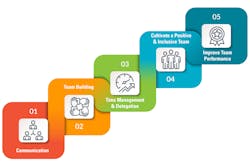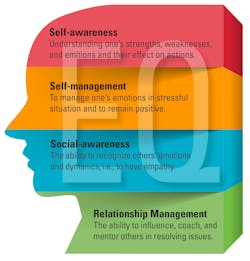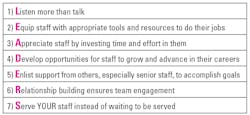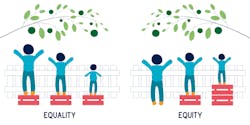Diversity, equity, inclusion — Managing and leading today’s diverse laboratory workforce
Laboratory workforce shortages have been a concern for many years. During this COVID era, there has especially been an impactful change as seen in all aspects of healthcare as well as many other industries that support it.1 In part, this reflects the ‘Great Resignation’ phenomena seen not only in the United States but in Europe and Asia. In 2021, over 47 million Americans quit their jobs, and in the last six months of 2021, almost 2.8 million healthcare workers resigned.2,3
In addition, social media has spawned a type of movement known as ‘Quiet Quitting’ referring to a growing number of workers who put in the least amount of effort, working no more than the minimally required number of hours, and expressing little or no enthusiasm for the job. It is estimated that over 50% of the U.S. workforce appear to be disengaged with their job with a particularly high number of Gen Zs and younger Millennials (< 35 years old) making up this contingency.4 A significant shift in priorities has occurred during this pandemic era resulting in a kind of worker clarity that will not accept traditional organizational practices that do not align with today’s thinking where many feel that they don’t “fit in.”5
Multicultural workforce
Multicultural workforce is a term that has most often been associated with racial or ethnic differences. Today’s workplace environment reflects a greater diversity of staff and patients yet preconceived inequities still remain. Our interactions with each other are broadly based on how we were raised, what we have learned from our parents, and the environment that we grew up in as we approached adulthood, regarding race, nationality, gender, religion, social groups, and/or other unique associations.6
During this COVID era, the difficulties in retaining staff have led to a closer examination of what is currently referred to as Diversity, Equity, and Inclusion (DEI) practices and their impact on hiring and managing staff. DEI can be viewed as a three-legged stool that supports the work environment and its workforce, something laboratory leaders need to examine, understand, and implement (Figure 1). While good laboratory leaders learn and become proficient in utilizing technical and managerial skills, great laboratory leaders possess certain innate skills that will cultivate a positive and inclusive work culture.Leg 1 — diversity
A diverse workforce reflects multiple persons and personalities, with different backgrounds, identities, and demographics.7 Diversity can serve as a metric in that each of the following can be counted and used as a base for developing and expanding diversity. Diversity discussions must not be limited to just that of race, ethnicity, or gender but also can include religion, sexual orientation, socioeconomic status, and age.
Diversity should also recognize situations that may arise due to differences in political or national views (e.g., Republicans versus Democrats), educational background differences (e.g., Syracuse University versus Georgetown University), physical differences (e.g., morbidly obese, ‘little person’), and those with mental health situations (e.g., anxiety, ADHD). In any given collection of people, any one or more of these areas when viewed to be a deficit or other limiting factor in job performance can result in a disproportionate, divisive, and unhealthy workforce. Therefore, it is incumbent upon laboratory leaders to recognize and work with staff in building an inclusive workforce that recognizes and accepts these differences.
Leg 2 — equity
Though a laboratory may have a diverse workforce, equity is an essential step in promoting fair access to opportunities, resources, and professional success. In other words, all employees are treated, evaluated, and supported in the same manner regardless of their ‘uniqueness.’ Studies have shown that employees who are treated fairly are almost ten times more likely to want to work, six times more prideful in their work, and five times more likely to be retained.8
Leg 3 — inclusion
Inclusion involves actions taken to understand and accept certain strengths and identities that contribute to better engaging employees in ways that make them feel and want to be part of a team. That is, they become part of the inner circle and actively make meaningful contributions. In a study by the Society for Human Resource Management,9 eighty-four percent of respondents felt that managers were poorly trained causing unnecessary work and stress. Five skills were also identified (Figure 2) as ways that managers could work to improve the workplace environment, which includes cultivating a positive and inclusive team.‘The Three Qs’
How do leaders learn and implement DEI? Looking at the ‘three Qs’ may be a good way to start. IQ, or Intelligence Quotient, serves as a key component in management for being smart enough to recognize and embrace needed changes.The third Q is Cultural Quotient (CQ; also known as Cultural Intelligence). Approximately 70 percent of international businesses fail due to a lack of understanding of cultural differences.12 Figure 4 shows the three components of CQ. With respect to DEI initiatives, this may be the most important Q in that a leader with a high CQ readily recognizes, relates to, and effectively works with others in various cross-cultural settings. A leader with a high CQ makes every effort to understand different beliefs, thoughts, activities, behaviors, and experiences that may be present in a diverse work environment.13 A short evaluation of CQ is provided in Earley & Mosakowski, 2004.14
These cultural settings can be viewed in two ways: those relationships that are influenced by genetic or familial-related situations and those that are developed through connections or non-genetic relationships. Cultural settings influenced by genetics include nationality, ethnicity, religion, race, and gender/sexuality. Non-genetic relationships may be thought of as a modified form of ‘tribalism’ where there is a sense of loyalty based on common beliefs, thinking, backgrounds, demographics, or behaviors and not necessarily based on genetic or familial relations. Consider diehard fans of a particular sports team. These collectives are often referred to as affinity groups (also called Employee Resource Groups or ERG). These gatherings can exist in many forms such as women’s leadership groups, religious groups, college alumni groups, and departmental baseball teams (e.g., Hematology versus Blood Bank), resulting in individuals who ‘look, talk, and act like me.’ These commonalities serve as a rallying point that leads to improved communication and cooperation among laboratory staff, other hospital staff, and even patients.Laboratory leadership and DEI
Because an organization may be considered diverse, it does not necessarily reflect equity and/or inclusion. In a study by McKinsey & Co., about $8 billion was spent on diversity training. More than half of the employees surveyed agreed that diversity efforts were acceptable, while 61 percent felt that inclusion efforts were less than acceptable.15
Equality does not necessarily mean equity. As seen in Figure 5, there is equal access to viewing a ball game over the fence, but not equal opportunity to participate. Similarly, employees may be equally presented with better positions, salary increases, more responsibilities, and education opportunities, but successfully obtaining access to them may be limited and can only be achieved through true equity practices. It should be noted that without equity, diversity and inclusion may not be achievable or sustainable.
This is reflected in inclusion options. Individuals that have been previously excluded from participation in certain opportunities may eventually be allowed to be peripherally integrated ‘around’ the inner circle, but never truly part of the inner circle. Implementing inclusion practices allows these individuals to be part of the ‘inner circle.’ They then can actively be involved and participate in developing policies and other opportunities within the organization.Potential fixes to ensuring DEI
Initiating DEI practices requires buy-in from the top levels of management who provide opportunities for meaningful conversations that identify accountability and actionable items. Consider some of the following suggestions:7
- Understanding and implementing DEI ensures that anti-discrimination laws are followed. According to the EEOC (Equal Employment Opportunity Commission), over sixty-one thousand workplace discrimination charges were filed in 2021 ranging from discrimination due to disabilities to improper use of genetic information.16
- Senior laboratory leaders should review their hiring practices by ensuring an appropriately written job description that would otherwise unfairly eliminate a candidate. It should also clearly identify physical/mental requirements to do the job with consideration of providing procedural accommodations if necessary (e.g., phone assistive listening device for the hearing impaired.)
- Advertise job opportunities that increase visibility and do not limit access to minorities or other underrepresented entities (women, people with disabilities, etc.). Social media has a number of platforms that readily accomplish this.17
- Use clear and concise language when speaking and writing. Avoid jargon, slang, idioms, or gender-slanted terms (he versus she, “an opportunity for working moms,” etc.).
- Actively listen and paraphrase to ensure you understand what is said to you.
- Use of salary history, previous employment absenteeism, or past criminal background has raised some legal discrimination issues; consult your Human Resource Department.
- When creating a hiring team, consider its diversity.
- Use a pre-set list of interview questions that are used for every candidate.
- Do not assume that a culturally different person is typical of that culture or group.
- Recognize your unintentional biases (microaggressions or stereotyping) that might eliminate a candidate or minimize a worker (i.e., names, attire, smoker, tattoos, etc.)
- Be aware of culturally acceptable body language (hand gestures, touching, eye contact, personal space, etc.).
- Develop and advertise your DEI-based hiring policy that promotes fair practices.
- Educate yourself about cultural differences (i.e., food, modesty issues, religious holidays/traditions, etc.)
Summary
Understanding and implementing DEI policies can be challenging yet becomes an important part in hiring, training, and retaining staff. It has been reported that companies that have a well-developed DEI program are 43 percent more likely to see higher profits. Executive team gender diversity has shown a 25 percent increased profitability and was more likely to outperform other companies by 30 percent. Management teams that are racially diverse tend to work more effectively than those that are not. And finally, three in four employees and job seekers value a diverse workplace, thus potentially improving recruiting and retention opportunities.7
Over the past several decades, diversity and affirmative action efforts have had limited impact focusing on only a few issues (race, religion, and sometimes gender). In a study by the American Hospital Association, as many as a third of hospital patients are minorities, yet only 14 percent are on hospital boards, 12 percent are in executive leadership positions, and 17 percent are in first- and mid-level management.18 Of note, Millennials and Gen Zs are more fluid in their interpretations and see lifestyle choices, experiences, and ideas are more relevant, thus creating a greater level of flexibility in workforce practices.
So how diverse is the laboratory? There are approximately 57,000 medical laboratory scientists, 65,000 medical laboratory technicians, and over 152,000 phlebotomists at an average age of about 43 years. Gender distribution is about two-thirds female and one-third male, yet there are more male laboratory managers (58%) than females (42%). Racial distribution is White (56%), Hispanic/Latino (16%), Asian (13%), and Black/African-American (12%). Of note, women earned 100% of what men do. And finally, about 12% identify as LGBTQ+.2
It is really easy to judge people based on their differences, but it takes effort to learn and understand, and accept these differences. Laboratory leaders can then build a balanced and functional workforce that works well together and is highly productive. It is equally important to remember that when patients, staff, and the general public see healthcare workers that look, act, and talk like them, there will be a greater sense of connectivity, acceptance, and understanding that promotes better patient care and a healthier work environment.
“Like a string of beads, it is our unique differences and intricacies that make us so appealing and attractive. We would not be as beautiful if we were all the same. It’s the contrast and asymmetry that makes us worthwhile.” –Lindsey Lunsford, M.E.M., Second edition DEI Fellow
References
1. Michel R. ‘lab workforce crisis takes top spot’–CAP today. The Dark Report. Published April 25, 2022. Accessed May 16, 2023. https://www.darkintelligencegroup.com/lab-marketplace/lab-workforce-crisis-takes-top-spot-cap-today/.
2. Flynn J. 20 stunning great resignation statistics [2023]: Why are Americans leaving their jobs? Zippia. Published October 12, 2022. Accessed May 16, 2023. https://www.zippia.com/advice/great-resignation-statistics/.
3. Clinical laboratories suffer during the ‘Great Resignation.’ Dark Daily. Published February 23, 2022. Accessed May 16, 2023. https://www.darkdaily.com/2022/02/23/clinical-laboratories-suffer-during-the-great-resignation/.
4. Harter J. Is quiet quitting real? Gallup. Published September 6, 2022. Accessed May 16, 2023. https://www.gallup.com/workplace/398306/quiet-quitting-real.asp.
5. Cincotta S. How your DEI programs can help reverse “The Great Resignation.” Aperian Global. Published October 22, 2021. Accessed May 16, 2023. https://www.aperianglobal.com/how-your-dei-programs-can-help-reverse-the-great-resignation/.
6. Kurec AS. Managing the multicultural workforce. Clin Leader Manage Rev. 2010;24(2):1-13.
7. Diversity, Equity, & Inclusion at work. Creating programs with tangible value. Business Management Daily. Published online 2022.
8. Bush M. Why is diversity and inclusion in the workplace important? Great place to Work. In: Why Is Diversity & Inclusion in the Workplace Important? | Great Place To Work®. 2021.
9. SHRM. Survey: 84 percent of U.S. workers blame bad managers for creating unnecessary stress. SHRM. Published August 12, 2020. Accessed May 16, 2023. https://www.shrm.org/about-shrm/press-room/press-releases/pages/survey-84-percent-of-us-workers-blame-bad-managers-for-creating-unnecessary-stress-.aspx.
10. Emotional intelligence in leadership: Why it’s important. Business Insights Blog. Published April 3, 2019. Accessed May 16, 2023. https://online.hbs.edu/blog/post/emotional-intelligence-in-leadership.
11. Craig H. 17 emotional intelligence tests & assessments (+ free quiz). Positivepsychology.com. Published February 3, 2019. Accessed May 16, 2023. https://positivepsychology.com/emotional-intelligence-tests/.
12. MindTools. Mindtools.com. Accessed May 16, 2023. https://www.mindtools.com/aymny4y/wibbekes-geoleadership-model.
13. MindTools. Mindtools.com. Accessed May 16, 2023. https://www.mindtools.com/aisl5uv/cultural-intelligence.
14. Earley PC, Mosakowski E. Cultural Intelligence. Harv Bus Rev. Published online October 1, 2004. Accessed May 16, 2023. https://hbr.org/2004/10/cultural-intelligence.
15. Agovino T. Companies try a new approach to diversity, equity and inclusion: Honest conversations. SHRM. Published August 4, 2020. Accessed May 16, 2023. https://www.shrm.org/hr-today/news/hr-news/pages/a-new-approach-to-diversity-equity-and-inclusion.aspx.
16. Charge Statistics (Charges filed with EEOC) FY 1997 Through FY 2021. US EEOC. Accessed May 16, 2023. https://www.eeoc.gov/data/charge-statistics-charges-filed-eeoc-fy-1997-through-fy-2021.
17. 17 free job posting sites - high traffic and 100% free. Betterteam. Published November 24, 2020. Accessed May 16, 2023. https://www.betterteam.com/free-job-posting-sites.
18. The new look of diversity in healthcare: Where we are and where we’re headed. Beckershospitalreview.com. Accessed May 16, 2023. https://www.beckershospitalreview.com/hospital-management-administration/the-new-look-of-diversity-in-healthcare-where-we-are-and-where-we-re-headed.html.
19. Nlctb.org. Accessed May 16, 2023. https://nlctb.org/tips/7-traits-of-emotionally-intelligent-leaders/?gclid=EAIaIQobChMImMOhxPWu8wIVhElyCh2UqAdsEAAYBCAAEgIOBvD_BwE.hbr.org.
About the Author

Anthony Kurec, MS, MASCP, MLT, H(ASCP)DLM
is Clinical Associate Professor, Emeritus, at SUNY Upstate Medical University in Syracuse, NY. He is also a member of the MLO Editorial Advisory Board.






